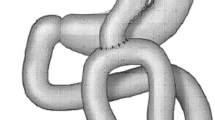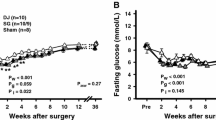Abstract
Background
Type 2 diabetes is an epidemic and insulin resistance is the central etiology of this disease. Obesity increases insulin resistance and glucose intolerance and also exacerbates metabolic abnormalities present in type 2 diabetes. Bariatric surgery is the most effective treatment for severe obesity. Most reported series show that return to euglycemia and normal insulin levels occur days after gastric bypass and biliopancreatic diversion, long before major weight loss has taken place. The mechanisms underlying this dramatic reversal of type 2 diabetes following these bariatric procedures are not well understood.
Methods
Twelve Wistar rats were fed with a palatable hyperlipidic diet for 12 weeks. Body weight, glucose, and intraperitoneal glucose tolerance test were measured regularly. On day 91, they were randomized in two groups (hindgut and controls) and operated. Twenty-one days later, the tests were done again and the hindgut group re-operated. A duodenal exclusion was done. The results of an intraperitoneal glucose tolerance test were compared after the procedures.
Results
Body weight increased regularly in all the rats. Some rats developed hyperglycemia 28 days after beginning hyperlipidic diet, but these levels returned to baseline on days 56 and 84. The glucose tolerance test showed an improvement in glycemic levels in the hindgut group 21 days after the first operation (151 ± 21mg/dl). After the second operation, despite weight loss, the glucose tolerance test of the foregut group worsened again (267 ± 53 mg/dl) (p < 0.01).
Conclusion
Comparing the “hindgut hypothesis” and the “foregut hypothesis”, our data show an improvement in the 30 min glucose tolerance test in the hindgut group.



Similar content being viewed by others
References
Venkat Narayan KM, Gregg EW, Fagot-Campagna A, et al. Diabetes:a common, growing, serious, costly, and potentially preventable public health problem. Diabetes Res Clin Pract. 2000;50(Suppl 2):S77–84.
Maggio CA, Pi-Sunyer FX. Obesity and type 2 diabetes. Endocrinol Metabol Clin. 2003;32(4):805–22.
Albu J, Pi-Sunyer FX. Obesity and diabetes. In: Bray GA, Bouchard C, James WPT, editors. Handbook of obesity. New York: Marcel Dekker; 1998. p. 697–707.
Mokdad AH, Ford ES, Bowman BA, et al. Diabetes trends in the US:1990–1998. Diabetes Care. 2000;23:1278–83.
Reaven GM, Banting lecture. Role of insulin resistance in human disease. Diabetes 1988;37:1595–1607.
Olefsky JM, Kolterman OG, Scarlett JÁ. Insulin action and resistance in obesity and noninsulin-dependent type 2 diabetes mellitus. Am J Physiol. 1982;243:E15–30.
Albu J, Raja-Khan N. The management of the obese diabetic patient. Prim Care Clin Office Pract. 2003;30:465–91.
Henry RR, Wallace P, Olefsky JM. Effects of weight loss on mechanisms of hyperglycemia in obese non-insulin-dependent diabetes mellitus 1986;35:990–8.
Sjöström L, Lindroos AK, Peltonen M, et al. Lifestyle, diabetes and cardiovascular risk factors 10 years after bariatric surgery. N Engl J Med. 2004;351:2683–93.
Colquitt J, Clegg A, Loveman E, et al. Surgery for morbid obesity. Cochrane Database Syst Rev. 2003;(2):CD003641.
Buchwald H, Avidor Y, Braunwald E, et al. Bariatric surgery: a systematic review and meta-analysis. JAMA 2004;292:1724–37.
Marceau P, Hould FS, Simard S, et al. Biliopancreatic diversion with duodenal switch. World J Surg. 1998;22:947–54.
Scopinaro N, Adami GF, Marinari GM, et al. Biliopancreatic diversion. World J Surg. 1998;22:936–46.
Schauer PR, Ikramuddin S, Gourash W, et al. Outcomes after laparoscopic Roux-en-Y gastric bypass for morbid obesity. Ann Surg. 2000;232:515–29.
Pories WJ, Swanson MS, MacDonald KG, et al. Who would have tought it? An operation proves to be the most effective therapy for adult-onset diabetes mellitus. Ann Surg. 1995;222:339–50.
Hickey MS, Pories WJ, MacDonald KG, et al. A new paradigm for type 2 diabetes mellitus: could it be a disease of the foregut? Ann Surg. 1998;227:637–44.
Cummings DE, Overduin J, Foster-Schubert KE. Gastric bypass for obesity: mechanisms of weight loss and diabetes resolution. J Clin Endocrinol Metab. 2004;89:2608–15.
Frezza EE. Are we closer to finding the treatment for type 2 diabetes mellitus in morbid obesity? Are the incretins the key to success? Obes Surg. 2004;14:999–1005.
Holst JJ. On the physiology of GIP and GLP-1. Horm Metab Res. 2004;36:747–54.
Kreymann B, Williams G, Ghatei MA, et al. Glucagon-like peptide 1 7–36: a physiological incretin in man. Lancet 1987;2:1300–04.
Farilla L, Bulotta A, Hirshberg B, et al. Glucagon-like peptide 1 inhibits cell apoptosis and improves glucose responsiveness of freshly isolated human islets. Endocrinology 2003;144:5149–58.
Patriti A, Facchiano E, Annetti C, et al. Early improvement of glucose tolerance after ileal transposition in a non-obese type 2 diabetes rat model. Obes Surg. 2005;15:1258–64.
Pories WJ, Albrecht RJ. Etiology of type II diabetes mellitus: role of the foregut. World J Surg. 2001;25:527–31.
Rubino F, Forgione A, Cummings DE, et al. The mechanism of diabetes control after gastrointestinal bypass surgery reveals a role of the proximal small intestine in the pathophysiology of type 2 diabetes. Ann Surg. 2006;244:741–9.
Estadella D, Oyama LM, Damaso AR, et al. Effect of palatable diet on lipid metabolism of sedentary and exercised rats. Nutrition 2004;20:218–24.
Vivas LAM, Jamel N, Refinetti RA, et al. Anesthetic experimental device for small animal. Acta Cir Brás. 2007;22(3):229–33.
Patriti A, Aisa MC, Annetti C, et al. How the hindgut can cure type 2 diabetes. Ileal transposition improves glucose and beta-cell function in Goto-Kakizaki rats through an enhanced proglucagon gene expression and L-cell number. Surgery 2007;142:74–85.
Prada PO, Zecchin HG, Torsoni MA, et al. Western diet modulates insulin signaling, c-jun N-terminal kinase activity and insulin receptor substrate-1ser307 phosphorylation in a tissue-specific fashion. Endocrinol 2005;146:1576–87.
Rubino F, Marescaux J. Effect of duodenal-jejunal exclusion in a nonobese animal model of type 2 diabetes. Ann Surg. 2004;239:1–11.
Pacheco D, Luis DA, Romero A, et al. The effects of duodenal-jejunal exclusion on hormonal regulation of glucose metabolism in Goto_kakizaki rats. Am J Surg. 2007;194:221–4.
Mason EE. Ileal transposition and enteroglucagon/GLP-1 in obesity (and diabetic?) surgery. Obes Surg. 1999;9:223–8.
Author information
Authors and Affiliations
Corresponding author
Rights and permissions
About this article
Cite this article
de Campos Martins, M.V.D., Peixoto, A.A., Schanaider, A. et al. Glucose Tolerance in the Proximal Versus the Distal Small Bowel in Wistar Rats. OBES SURG 19, 202–206 (2009). https://doi.org/10.1007/s11695-008-9651-3
Received:
Accepted:
Published:
Issue Date:
DOI: https://doi.org/10.1007/s11695-008-9651-3




